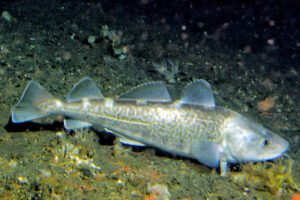
Pacific cod have expanded their summer travel range into the northern Bering Sea due to warming waters to the south, but appear to be migrating back to their typical spawning grounds in winter where their eggs are more likely to survive and hatch.
That’s what scientists at the Alaska Fisheries Science Center in Seattle say they’re observing in their ongoing research on how Pacific cod will find suitable spawning habitat as new climate conditions in the ocean evolve in the 21st century.
“There is always potential for adaptation, but it is typically slow,” said ecologist Lauren Rogers, also a co-author and colleague of Jennifer Bigman, the lead in the latest NOAA Fisheries research release on spawning habitat in the Bering Sea.
“I think the bigger question is whether they will adapt to the warmer conditions they’ll experience on the outer Bering Sea shelf and slope, where they appear to currently spawn,” Rogers said. “Temperatures are projected to warm there through the century. However, given that these fish are capable of long-distance migrations, it seems likely that they may develop some new migratory strategies to make the most of summer feeding conditions and winter spawning conditions.”
Pacific cod, found in the coastal North Pacific Ocean, from the Bering Sea to Southern California, are a multi-million-dollar groundfish fishery. In 2021, according to NOAA Fisheries, the commercial harvest of Pacific cod totaled 330.4 million pounds and was worth $86.5 million.
Collaborative research results released in late June project that suitable spawning habitat will expand and shift over this century, with current spawning hotspots likely to become too warm for egg development and hatching. At the same time, researchers hypothesized, the northern Bering Sea will remain too cold for successful spawning even by the end of the century.
“Understanding how warming will affect spawning habitat is a critical step in predicting and mitigating the effects of climate change on Pacific cod populations and fisheries,” Bigman said.
Researchers are integrating physiological data with climate modeling to gain insight into how climate might drive change.
The research report notes that laboratory experiments have shown that Pacific cod eggs have a very narrow thermal window for successful development and hatching, and that juvenile Pacific cod and adults tolerate a much wider temperature range. The egg stage may act as a bottleneck for the species’ ability to adapt to warming, the report states.
Still, Rogers noted, researchers did not find that overall spawning habitat suitability was correlated with recruitment, the number of new fish entering the population. She said it is likely that other factors are more important for the stock size, such as prey availability, juvenile habitat, larval dispersal pathways and predation, to name a few.
Based on these factors, Rogers said, she would not expect the lack of spawning habitat in the northern Bering Sea to necessarily bode ill for this stock.
“Habitat suitability is projected to increase across the Bering Sea shelf, providing lots of options for spawning in the future, just not in the north,” she said.
Recent studies noted in the new research report have linked reduced thermal spawning habitat with a stark decline in Pacific cod production in the Gulf of Alaska following an unprecedented marine heatwave in 2014-2016. But the Bering Sea is colder than the Gulf of Alaska.
“Bering Sea Pacific cod populations are currently constrained by cold rather than warm temperatures,” Bigman said. “Much of the Bering Sea is too cold for eggs to successfully hatch.
“The study was undertaken to find out whether or when warming might affect Pacific cod populations through shifts in spawning habitat.”
The study itself found no correlation between the extent of spawning habitat and recruitment.
“Our results suggest that thermally suitable spawning habitat has not limited reproductive potential of Pacific cod in the eastern Bering Sea in the past—nor is it likely to in the future,” Bigman said.
Realized spawning habitat—where fish actually spawn—is determined not just by ocean temperature, but also by oxygen levels, water movement and transport, food and refuge from predators.
“Spawning adults are targeted by the commercial fishery,” Rogers said. “Our study suggests that spawning locations may shift as temperatures warm. That could affect when, where and how people fish.”
Overall, the study findings may be cause for optimism regarding Pacific cod in the Bering Sea.
“Pacific cod in the Gulf of Alaska was a sad story,” Rogers said. “As it warms there, it’s less and less likely to be suitable habitat for spawning. But warming will actually increase the amount of habitat where Pacific cod can spawn and hatch in the Bering Sea. In some ways, it’s a good news story.”
